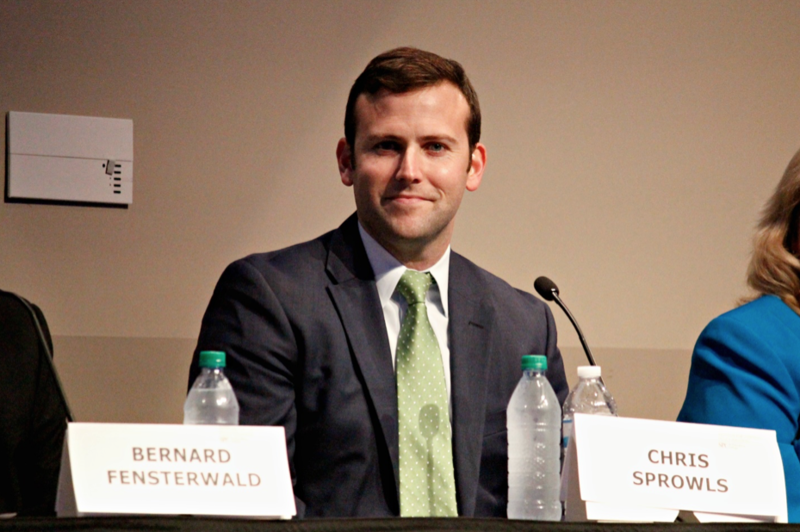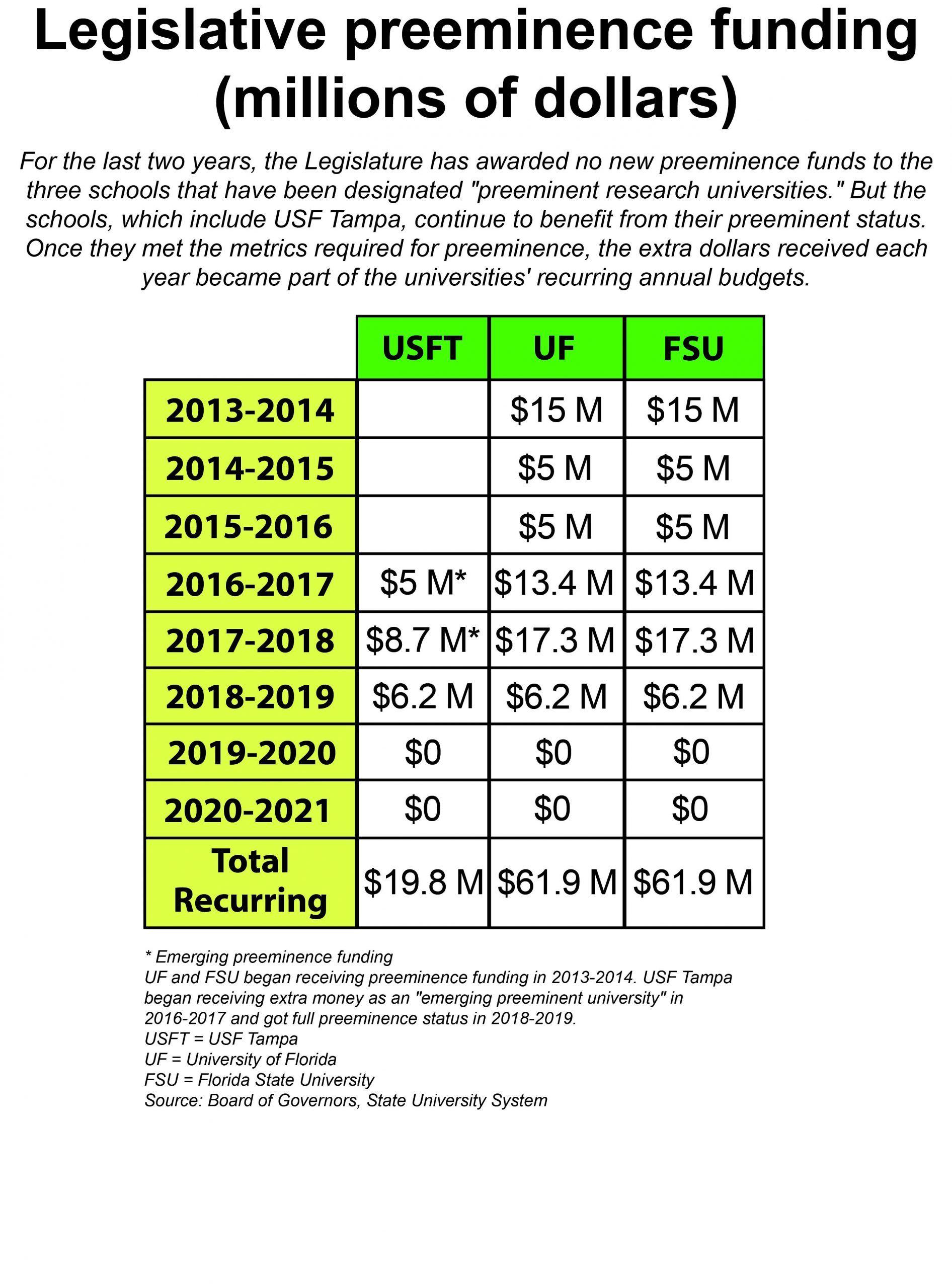Pictured above: MK Brittain | The Crow’s Nest
By Nancy McCann
For the second year in a row, the Florida Legislature has awarded no new preeminence funds to the state’s three preeminent research universities.
This seems to undercut the argument of the Pinellas County legislators who led the surprise move in 2018 to abolish the independent accreditations of USF St. Petersburg and USF Sarasota-Manatee so they could join with Tampa to become one university this July.
Once the three campuses were consolidated, those lawmakers said, the two smaller campuses would share in the prestige and extra funds that come with preeminence.
But some in St. Petersburg contend that – so far at least – consolidation has redounded to the disadvantage of the campus.
Although data from St. Petersburg and Sarasota-Manatee will not be counted in USF’s preeminence metrics until 2022, the two smaller campuses had to rapidly raise their admission standards to match Tampa’s – ensuring that the university continues to meet a key metric required to maintain preeminent status.
The result: A stunning decline in freshman applications and enrollment in St. Petersburg from 2017 to 2019.
And now, for the second straight year, the Legislature has turned off the spigot of new money for preeminence.
Rep. Chris Sprowls, R-Palm Harbor, a legislative leader who was the principal architect of consolidation, continues to defend the move as a positive step for St. Petersburg.
In an email response to questions from The Crow’s Nest, he brushed off a question about the lack of new preeminence money and stressed what he called the pluses for St. Petersburg.
“While the legislature has handled preeminence (funding) differently the past couple of years, there has been nothing but positive impact financially for USFSP in the (state) budget,” he said.
“They have received an additional 6.5 Million (dollars) in operational support these past two years. That is the largest operational support increase in the history of the Campus.
“I stand by what I have always said – that a rising tide lifts all boats,” Sprowls said.
“The USF system will all be a Tier 1 research University, and a preeminent State University. Their students will have access to more and better programs, and the rise of USF and her students will be a victory for the whole Tampa Bay Region. Every campus and their students deserve to share in that success, USFSP among them.”
Sprowls, who is chairman of the House Rules Committee and speaker-designate for the House in 2021-2022, did not respond to other questions from The Crow’s Nest. (See his exchange with the newspaper, below.)
$6.5 million in ‘operational support’
The $6.5 million in “operational support” that Sprowls cited came from the Legislature in 2019, said Carrie O’Brion, USF St. Petersburg’s director for marketing and communications.
The money is split between the 2019-2020 and 2020-2021 budgets, she said, and “is being used for vital infrastructure for our faculty, students and staff to prepare us for the transition to a research intensive university.
“This includes everything from upgrading labs and classrooms to hiring teaching assistants and key positions that position us to contribute to a nationally-ranked, preeminent university.”
History professor Ray Arsenault, the president of the USF St. Petersburg Faculty Senate, said he was unaware that the campus got the $6.5 million in operational support.
While he welcomed that news, he criticized the campus administration for not spelling out how the money is being used.
“The additional $6.5 million in funding is welcome, but the lack of transparency concerning how these funds have or will be spent has caused unnecessary anxiety and dissension,” Arsenault said.
“The statement by Carrie O’Brion is too vague to be of much help,” he said. “USFSP faculty members deserve to be informed of the budgetary specifics.
“We need to know exactly how the additional funds will be used. The USFSP (Faculty) Senate should be provided with a detailed list of allocations, a list that can be shared with the broader faculty. To do otherwise is to violate the spirit of shared governance.”
Arsenault also took issue with Sprowls’ optimistic take on how consolidation will affect the St. Petersburg campus.
“Impending consolidation may not have cost USFSP any funding as of yet,” Arsenault said, “but there have been other deficits — our first-time-in-college enrollment has been decimated, and many faculty members are wracked with anxiety and uncertainty about the future of the campus and the well-being of our students.”
The preeminence program
The preeminent university program was created by the state in 2013 to reward high achieving universities that meet or exceed 11 of 12 benchmarks – or metrics – of excellence.
They include certain admission standards, student retention and graduation rates, research expenditures, size of endowment and the number of patents awarded to research faculty.
(What are the 12 metrics of preeminence? See chart that accompanies this prior story)
The University of Florida and Florida State were awarded preeminent status – and $15 million each in extra funding – in 2013-2014.
USF Tampa was designated an “emerging preeminent” university in 2016-2017 (which meant $5 million in extra funds) and 2017-2018 ($8.7 million) and achieved full preeminence in 2018-2019 (see chart, above).
Even without new preeminence funding, USF Tampa, FSU and UF continue to benefit financially from preeminent status. Once they met the metrics required for preeminence, the extra dollars received each year became part of the three universities’ recurring budgets.
But USF Tampa, the university most recently designated as preeminent, has a significantly smaller amount in its annual budget from preeminence funding than FSU and UF, which started receiving it earlier.
USF Tampa has $19.8 million in its recurring budget due to prior years’ preeminence funding (including the emerging preeminence years) while FSU and UF each have $61.9 million.
The USF system’s total annual budget is $1.8 billion.
Martin Tadlock, USF St. Petersburg’s regional chancellor, said that even though there’s been no new preeminence funding for two years, it’s not just about the money.
“The metrics for preeminence lead to possible AAU (Association of American Universities) membership, and we need to be aligned and supportive in that,” he said.
AAU is considered an elite group, with 63 public and private members in the United States and two in Canada. They are judged to be leaders in innovation, scholarship and contributions to society.
UF is the only Florida school on the list, which includes Princeton, Yale, Columbia, Stanford, Duke, Purdue, the University of Michigan, Georgia Tech and Texas A&M.
“Our (USF) Board of Trustees’ goal is to be a member of the AAU, and we have to be invited,” Tadlock said.
Has preeminence funding become a passing fad?

Here are the questions that The Crow’s Nest sent to Rep. Chris Sprowls, the principal architect of the 2018 law abolishing the independent accreditation of USF St. Petersburg and consolidating the three campuses of the USF system.
Representative Sprowls:
For the second year in a row, the Florida Legislature awarded no new preeminence funding.
In the meantime, raising admissions standards to achieve a higher student profile at USF St. Petersburg to prepare for consolidation and maintain preeminence is causing dramatic declines in freshman admission applications and enrollment at the St. Pete campus.
The target provided by the USF system administration for 2020 freshman enrollment at USF St. Petersburg is also very low.
When in 2018 you and fellow Pinellas legislators sprang the surprise legislation to consolidate the three USF campuses, you said repeatedly that consolidation would enable St. Petersburg and Sarasota-Manatee to get a share of the preeminence money that would be flowing to Tampa.
You dismissed concerns raised on the St. Petersburg campus and in the Pinellas community that consolidation would do more harm than good, undermining the campus’ recent achievements and momentum.
Some see preeminence funding as paltry even though the awards are recurring funds – just $6.15 million for the Tampa campus (starting in 2018) compared to a $1.8 billion annual operating budget for the USF system. And now for two years in a row the Legislature has added nothing to that sum.
Here are our questions:
- What would you say to the St. Petersburg campus and community about the Legislature’s decision in 2019 and 2020 to withhold additional funding for preeminence? Has preeminence funding become a passing fad?
- St. Petersburg and Sarasota-Manatee are not even eligible for a share of preeminence money until 2022. Yet they are being compelled to dramatically raise their metrics right away. Is that fair to those campuses and prospective students?
- At least twice, you and the Pinellas delegation have stepped in to block the Tampa administration’s attempts to neuter the two regional chancellors and give virtually all authority for academic and student services to Tampa. You are (incoming) House speaker now. Who will protect the two smaller campuses when you leave the Legislature (in 2022)?
This is Sprowls’ response:
While the legislature has handled preeminence differently the past couple of years, there has been nothing but positive impact financially for USFSP in the budget. They have received an additional 6.5 Million in operational support these past two years. That is the largest operational support increase in the history of the Campus.
I stand by what I have always said, that a rising tide lifts all boats.
The USF system will all be a Tier I research University, and a preeminent State University. Their students will have access to more and better programs, and the rise of USF and her students will be a victory for the whole Tampa Bay Region.
Every campus and their students deserve to share in that success, USFSP among them.



